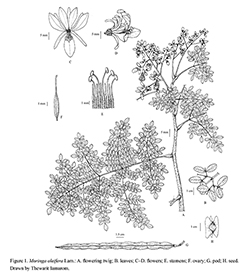e-Flora of Thailand
Volume 14 > Part 1 > Year 2018 > Page 44 > Moringaceae > Moringa
Moringa oleifera Lam.wfo-0001085051
Encycl. 1: 398. 1785; Steenis in Steenis, Fl. Males., Ser. I, Spermat. 4: 45. 1949; Vidal, Fl. Cambodge, Laos & Vietnam 2: 4. 1962; Lu & Olson in P.H.Raven et al., Fl. China 8: 196. 2001. Fig. 1.
Accepted Name : This is currently accepted.
Synonyms & Citations :
Description : Tree 3–10 m tall; stem crooked; young shoots puberulous; branchlets thick, lenticellate, with obvious scars. Leaves often crowded near ends of twigs, 2–4-pinnate, 20–60 cm long; rachis articulate, with linear or clavate glands; primary pinnae 8–10 pairs; leaflets ovateoblong or obovate-oblong, 1–2.5 by 0.5–2 cm, base oblique, cuneate or rounded, apex obtuse or subemarginate, whitish mucronulate, glabrous, pale green below, veins 6–8, inconspicuous; stalked glands at base of petiolules; petiole pulvinate at base, 8.5–10 cm long, leaf axis 16.5–20 cm long. Panicles 10–30 cm long; pedicels 0.7–1 cm long. Calyx ca 1.5 cm long. Petals lanceolate, 1–2 by 0.5–0.8 cm, puberulous, base short stalked, apex acute. Stamens and staminodes pubescent at base, turned towards largest petal, filament recurved at apex. Ovary 3–4 mm long, densely hairy, style filiform, 2–3 mm, erect, glabrous. Capsule pendulous, dagger-shaped, 18–45 cm long, acuminate, subconstricted, costate. Seeds broadly elliptic or suborbicular, ca 1.5 by 1 cm; wings 2.5–3 by 0.4–0.7 cm.
Thailand : Cultivated throughout.
Distribution : NW India. Widely cultivated.
Ecology : Flowering and fruiting all year round.
Vernacular : Phak i-hum (ผักอีฮุม), phak i-huem (ผักอีฮึม)(Northern); ma rum (มะรุม)(Central, Peninsular).
CommonName : Horseradish tree.
Uses: All parts used for medicinal purposes. Young fruit, leaves and flowers are edible.

